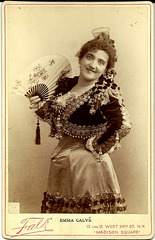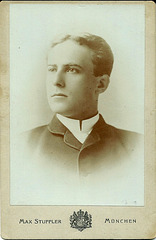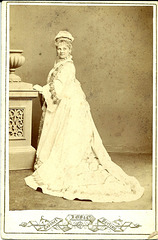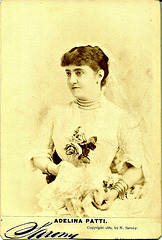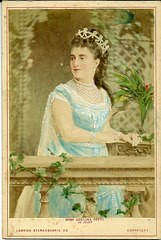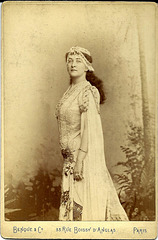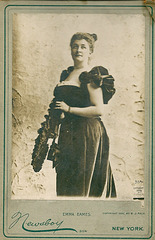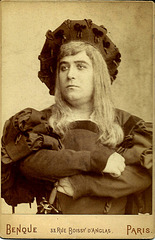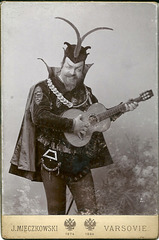
19TH CENTURY OPERA SINGERS
Emma Calve by Falk
| |
|
Emma Calve as Carmen 'Carmen" Bizet
EMMA CALVE
(Rosa Emma Calvet de Noëmie Roquer)
(August 15, 1858 – January 6, 1942), French Soprano
Her operatic debut occurred on September 23, 1881, in Gounod's Faust at Brussels' La Monnaie. Later she sang at La Scala in Milan, and also at the principal theatres of Naples, Rome, and Florence.
Returning to Paris in 1891, she created the part of Suzel in L'amico Fritz by Pietro Mascagni, playing and singing the role later at Rome. Because of her great success in it, she was chosen to appear[citation needed] as Santuzza in the French premiere of Cavalleria rusticana, which was viewed as one of her greatest parts. She repeated her success in it in London.
Her next triumph was Bizet's Carmen. Before beginning the study of this part, she went to Spain, learned the Spanish dances, mingled with the people and patterned her characterization after the cigarette girls whom she watched at their work and at play. In 1894, she made her appearance in the role at the Opéra-Comique, Paris. The city's opera-goers immediately hailed her as the greatest Carmen that had ever appeared, a verdict other cities would later echo. She had had many famous predecessors in the role, including Adelina Patti, Minnie Hauk and Célestine Galli-Marié, but critics and musicians agreed that in Calvé they had found their ideal of Bizet's cigarette girl of Seville.
Calvé first appeared in America in the season of 1893–1894 as Mignon. She would make regular visits to the country, both in grand opera and in concert tours. After making her Metropolitan Opera debut as Santuzza, she went on to appear a total of 261 times with the company between 1893 and 1904. She created the part of Anita, which was written for her, in Massenet's La Navarraise in London in 1894 and sang Sapho in an opera written by the same composer.
She sang Ophélie in Ambroise Thomas's Hamlet in Paris in 1899, but the part was not suited to her and she dropped it. She appeared with success in many roles, among them, as the Countess in The Marriage of Figaro, the title role in Félicien David's Lalla-Rookh, as Pamina in The Magic Flute, and as Camille in Hérold's Zampa, but she is best known as Carmen
.
Jean Francois Delmas by DuGuy
| |
|
Jean Francois Delmas as Duc de Guise in "Roi de Paris" Hue
CREATOR ROLE PALAIS GARNEIR 26/4/1901
JEAN FRANCIS DELMAS
Lyon, April 14, 1861-73.Saint - Alban-de-Monthel, 29 September 1933). French Bass
Debut September 28, 1886 in LES HUGUENOTS (Saint-Bris). Sings the FREISCHÜTZ (Gaspard, 1886), AIDA (the King), FAUST (Mephistopheles) in 1887. DON JUAN (Leporello, 1887; don Juan, 1902), SIGURD (Hagen, 1891), William TELL (Gessler), the Sicilian (Connie) in 1892. OTHELLO (Iago, 1894), TANNHÄUSER (Landgrave, 1895); Romeo and Juliet (brother Laurent), fatherland! (de Rysoor), LE CID (don Diego), ALCESTE (high priest) in 1900; HENRY VIII (Henry VIII, 1903), ARMIDE (Hidraot, 1905), the DAMNATION of FAUST (Mephistopheles, 1906), SAMSON ET DALILA (high priest), HIPPOLYTE and ARICIE (Thésée) in 1908. ŒDIPE A column (Oedipus),. BRISEIS (Strakokles) in 1916. Is the creator of LA DAME DE MONSOREAU (Monsoreau), ROMEO ET JULIETTE (Capulet), ZAIRE (Jeanette); on March 16, 1891 LE MAGE (Amrou) de Jules Massenet LOHENGRIN (King), SALAMMBÔ (Nar-Havas), die WALKÜRE (Wotan). on March 16, 1894 THAÏS (Athanaël) by Jules Massenet; HELLE (Gautier), MESSIDOR (Mathias),LES MAITRES CHANTEURS DE NUREMBERG (Hans Sachs), BURGONE (Attila), JOSEPH (Jacob), ASTARTE (Phur); on April 26, 1901LE ROI DE PARIS (Henri, Duke of Guise) of Georges Hüe. THE LES BARBARES (Scaurus), SIEGFRIED (Wotan), ORSOLA (Bishop), bench (Tonio),LA STATUE (Arnigiad), L’ETRANGER (l'Etranger), LE FILS DE L'l'ETOILE (Akiba), TRISTAN & ISOLDE (Kurwenal), DARIA (Yvan),LA GLOIRE DE CORNEILLE (Auguste), ARIANE (Parithoils), LA CATALANE (Miguel), Twilight of the gods (Hagen), MONNA VANNA (Marco), RHEINGOLD (Wotan), LA Forêt (Pierre), ICARE (Daedalus), ROMA (Fabius), FERVAAL (Arfagard), PARSIFAL (Gurnemanz), L'OURAGAN (Gervais), La Roman le ESTELLE (Rubini), La GIRONDINS (Fonfrède), JEANNE d'Arc (Jacques d'Arc), INTERMEDE (Pierre Dupont), La Legende of SAINT Christoph (the hermit), ANTAR (Malek), LA FILLE DE ROLAND (Charlemagne), LES BURGRAVES (the beggar).
Participated in the first performance
December 24, 1923 of ESCLARMONDE (Emperor Phorcas) by Jules Massenet. He created at the Nouveau-Théâtre 26 April 1906 le Clown (Barbazan) of Isaac de Camondo.
Max Alvery by Max Stuffler
| |
|
MAX ALVERY
(Maximilian Achenbach)
(May 3, 1856 – November 7, 1898), German tenor.
Born in Düsseldorf, Germany, he was the son of the painter Andreas Achenbach, over whose initial objections he pursued his singing career. He studied in Frankfurt with Julius Stockhausen, and in Milan with Francesco Lamperti.
He had a fine dramatic voice and a handsome stage presence, and speedily made a reputation in Germany in the leading roles in Wagnerian opera. From 1885 onwards he also appeared in America and England. On November 9, 1887, Alvary appeared as the title character in the United States premiere of Wagner's Siegfried at the Metropolitan Opera in New York. Vividly embodying Siegfried's youth and fiery individualism, the tenor created a sensation and became an idol of New York opera goers until his departure in 1889. In 1892, his performances as Tristan und Isolde and Siegfried at the Royal Opera House, Covent Garden, aroused great enthusiasm.
In October 1894, he was seriously injured in a fall while rehearsing Siegfried at Mannheim and never fully recovered; he retired from the stage in 1897.Alvary died in Großtabarz, Thuringia, Germany, in 1898.
Emilie Melville by Johnstone O'Shannessy & Co
| |
|
Emilie Melville as Violetta "'La Traviata"
EMILIE MELVILLE
1850-1932
American Soprano/Actress
Emilie was only five years old when she played the Duke of York to Edwin Forrest's Richard III in Providence, Rhode Island, the Philadelphian was a popular child star in Louisville and elsewhere on what was called the “Western” circuit. She moved to San Francisco in 1868 and for the next sixty years remained one of its most beloved singers. Much of her early success was as the prima donna of contemporary comic operas, but Melville also earned acclaim for her Ophelia and other dramatic interpretations. As late as the 1920s she played important older parts with the Alcazar Theatre's famous stock company and at other local playhouses
Adelina Patti by Sarony (4)
| |
|
ADELINA PATTI
(19 February 1843 – 27 September 1919)
Soprano
Her voice was noticed very early and she nade her first tour in America at the age of seven years and was a huge success. Studied singing in New York under the direction of Maurice Strakosch, her brother-in-law, and in 1859 she sang in New York in Lucia di Lammermoor. At Covent Garden theatre in London in 1861 where she sang la Sonnambula, her reputation was strengthened and in 1862 she was singing in Paris at the Théâtre Italien, where she soon became the star. She remained at Paris until 1870, being heard in London during the summer season. In Paris she sang the Italian Repertory, in London the french Repertory. After a long stay in America and London, Patti returned several times to Paris at the Opera (debut in 1874) and the Théâtre de la Gaîté. Then she resumed travels and successfully created, in London, in 1882, the Charles Lenepveu's Velléda. She also created Dolores of André Pollonais in Nice on February 22, 1897. She triumphed especially in a vast Italian repertoire that suited to her beautiful light soprano voice. His career lasted for fifty-six years.
Adelina Patti by Sarony (5)
| |
|
ADELINA PATTI
(19 February 1843 – 27 September 1919)
Soprano
Her voice was noticed very early and she nade her first tour in America at the age of seven years and was a huge success. Studied singing in New York under the direction of Maurice Strakosch, her brother-in-law, and in 1859 she sang in New York in Lucia di Lammermoor. At Covent Garden theatre in London in 1861 where she sang la Sonnambula, her reputation was strengthened and in 1862 she was singing in Paris at the Théâtre Italien, where she soon became the star. She remained at Paris until 1870, being heard in London during the summer season. In Paris she sang the Italian Repertory, in London the french Repertory. After a long stay in America and London, Patti returned several times to Paris at the Opera (debut in 1874) and the Théâtre de la Gaîté. Then she resumed travels and successfully created, in London, in 1882, the Charles Lenepveu's Velléda. She also created Dolores of André Pollonais in Nice on February 22, 1897. She triumphed especially in a vast Italian repertoire that suited to her beautiful light soprano voice. His career lasted for fifty-six years.
Adelina Patti by London Sterographic Co (1)
| |
|
Adelina patti as juliette 'Romeo & Juliette" Gounod
ADELINA PATTI
(19 February 1843 – 27 September 1919)
Soprano
Her voice was noticed very early and she nade her first tour in America at the age of seven years and was a huge success. Studied singing in New York under the direction of Maurice Strakosch, her brother-in-law, and in 1859 she sang in New York in Lucia di Lammermoor. At Covent Garden theatre in London in 1861 where she sang la Sonnambula, her reputation was strengthened and in 1862 she was singing in Paris at the Théâtre Italien, where she soon became the star. She remained at Paris until 1870, being heard in London during the summer season. In Paris she sang the Italian Repertory, in London the french Repertory. After a long stay in America and London, Patti returned several times to Paris at the Opera (debut in 1874) and the Théâtre de la Gaîté. Then she resumed travels and successfully created, in London, in 1882, the Charles Lenepveu's Velléda. She also created Dolores of André Pollonais in Nice on February 22, 1897. She triumphed especially in a vast Italian repertoire that suited to her beautiful light soprano voice. His career lasted for fifty-six years.
Fides Devries by Benque
| |
|
FIDES DEVRIES
American Soprano
Fidès was born in New Orleans on 22 April 1852, and died in 1941, and was a soprano who studied under Duprez. She made her debut as Rose-de-Mai in Le val d'Andorre at the Théâtre Lyrique in October 1868. After a couple of seasons at La Monnaie in Brussels, she joined the Paris Opera in 1871, where her repertoire included Marguerite in Faust, Ophélie in Hamlet, Isabelle in Robert le diable, Agathe in Le Freischutz, Inès and Sélika in L’Africaine, Elvira in Don Juan, Mathilde in Guillaume Tell and Eudoxie in La Juive.
In February 1873 Devriès took the solo soprano part in Beethoven’s Choral Symphony with the Société des Concerts du Conservatoire, along with an aria from Don Giovanni
She interrupted her career from April 1874 to 1883, after which she appeared at the Théâtre-Italien directed by Victor Maurel, singing in Simon Boccanegra and Hérodiade. Back at the Opéra, after touring to Monte-Carlo, Madrid, Lisbon and Holland, she created the role of Chimène in the premiere of Le Cid on 30 November 1885. Her final major appearance was as Elsa in the French premiere of Lohengrin on 3 May 1887, before retiring from the stage in 1889
Emma Eames by Benque
| |
|
EMMA EAMES
(August 13, 1865 - June 13, 1952)
American Soprano
Eames was born in Shanghai, China and raised in Portland and Bath in the American state of Maine.She attended school in Boston where she studied singing with Charles R. Adams.Later she took voice lessons in Paris with the highly successful but autocratic teacher of bel canto sopranos, Mathilde Marchesi.
Eames made her professional operatic debut in Gounod's Roméo et Juliette at the Paris Opéra's headquarters, the Palais Garnier, in 1889. She would perform the role of Juliette many other times during the next two years, while adding other leading French-opera parts to her repertoire. As early as November 1889, The Times newspaper called her "the favourite cantatrice of the Opera". She left the company in 1891, however, for personal reasons. Towards the end of 1891, Eames debuted at the Metropolitan Opera in New York City in her trademark part of Juliette, and she quickly became a favourite with Met audiences. She would perform regularly at the Met in a variety of operas until 1909, when a dispute with management precipitated her departure. Eames also made a number of successful appearances at London's Royal Opera House, Covent Garden. She sang there intermittently from 1891 to 1901 and established herself as a genuine rival to Covent Garden's reigning diva, Nellie Melba, whom she heartily disliked. Eames also sang in Madrid and fulfilled lucrative singing engagements at Monaco's chic Monte Carlo Opera during the 1890s.
In 1906, Eames visited San Francisco with a touring troupe of leading Met singers. She was fortunate to survive unscathed when a devastating earthquake and fire struck the city, damaging her hotel. Eames gave her farewell operatic performances during the 1911-12 seasons with the Boston opera company. She then undertook a series of concert tours of the United States
Emma Eames by Benque
| |
|
Emma Eames As Colombe d'Estourville 'Ascanio" Saint Seans CREATOR ROLE
EMMA EAMES
(August 13, 1865 - June 13, 1952)
American Soprano
She attended school in Boston where she studied singing with Charles R. Adams.Later she took voice lessons in Paris with Mathilde Marchesi.
Operatic debut in Gounod's Roméo et Juliette at the Paris at Palais Garnier, in 1889. She would perform the role of Juliette many other times during the next two years, while adding other leading French-opera parts to her repertoire. As early as November 1889, She left the company in 1891, Towards the end of 1891, Eames debuted at the Metropolitan Opera in New York City in her trademark part of Juliette, and she quickly became a favourite with Met audiences. She would perform regularly at the Met in a variety of operas until 1909, Eames also made a number of successful appearances at London's Royal Opera House, Covent Garden. She sang there intermittently from 1891 to 1901 and established herself as a genuine rival to Covent Garden's reigning diva, Nellie Melba she also sang in Madrid Monte Carlo Opera during the 1890s.
In 1906, Eames visited San Francisco with a touring troupe of leading Met singers.Her farewell operatic performances was during the 1911-12 seasons with the Boston opera company. She then undertook a series of concert tours of the United States
Emma Eames by Reutlinger
| |
|
Emma Eames as Elsa in " Lohengrin" Wagner
EMMA EAMES
(August 13, 1865 - June 13, 1952)
American Soprano
She attended school in Boston where she studied singing with Charles R. Adams.Later she took voice lessons in Paris with Mathilde Marchesi.
Operatic debut in Gounod's Roméo et Juliette at the Paris at Palais Garnier, in 1889. She would perform the role of Juliette many other times during the next two years, while adding other leading French-opera parts to her repertoire. As early as November 1889, She left the company in 1891, Towards the end of 1891, Eames debuted at the Metropolitan Opera in New York City in her trademark part of Juliette, and she quickly became a favourite with Met audiences. She would perform regularly at the Met in a variety of operas until 1909, Eames also made a number of successful appearances at London's Royal Opera House, Covent Garden. She sang there intermittently from 1891 to 1901 and established herself as a genuine rival to Covent Garden's reigning diva, Nellie Melba she also sang in Madrid Monte Carlo Opera during the 1890s.
In 1906, Eames visited San Francisco with a touring troupe of leading Met singers.Her farewell operatic performances was during the 1911-12 seasons with the Boston opera company. She then undertook a series of concert tours of the United States
Emma Eames by Falk
| |
|
Emma Eames as Juliette 'Romeo & Juliette" Gounod
EMMA EAMES
(August 13, 1865 - June 13, 1952)
American Soprano
She attended school in Boston where she studied singing with Charles R. Adams.Later she took voice lessons in Paris with Mathilde Marchesi.
Operatic debut in Gounod's Roméo et Juliette at the Paris at Palais Garnier, in 1889. She would perform the role of Juliette many other times during the next two years, while adding other leading French-opera parts to her repertoire. As early as November 1889, She left the company in 1891, Towards the end of 1891, Eames debuted at the Metropolitan Opera in New York City in her trademark part of Juliette, and she quickly became a favourite with Met audiences. She would perform regularly at the Met in a variety of operas until 1909, Eames also made a number of successful appearances at London's Royal Opera House, Covent Garden. She sang there intermittently from 1891 to 1901 and established herself as a genuine rival to Covent Garden's reigning diva, Nellie Melba she also sang in Madrid Monte Carlo Opera during the 1890s.
In 1906, Eames visited San Francisco with a touring troupe of leading Met singers.Her farewell operatic performances was during the 1911-12 seasons with the Boston opera company. She then undertook a series of concert tours of the United States
Emma Eames by Newsboy
| |
|
EMMA EAMES
(August 13, 1865 - June 13, 1952)
American Soprano
She attended school in Boston where she studied singing with Charles R. Adams.Later she took voice lessons in Paris with Mathilde Marchesi.
Operatic debut in Gounod's Roméo et Juliette at the Paris at Palais Garnier, in 1889. She would perform the role of Juliette many other times during the next two years, while adding other leading French-opera parts to her repertoire. As early as November 1889, She left the company in 1891, Towards the end of 1891, Eames debuted at the Metropolitan Opera in New York City in her trademark part of Juliette, and she quickly became a favourite with Met audiences. She would perform regularly at the Met in a variety of operas until 1909, Eames also made a number of successful appearances at London's Royal Opera House, Covent Garden. She sang there intermittently from 1891 to 1901 and established herself as a genuine rival to Covent Garden's reigning diva, Nellie Melba she also sang in Madrid Monte Carlo Opera during the 1890s.
In 1906, Eames visited San Francisco with a touring troupe of leading Met singers.Her farewell operatic performances was during the 1911-12 seasons with the Boston opera company. She then undertook a series of concert tours of the United States
Henry Sellier & Caroline Salla by Benque
| |
|
|
Henrie Sellier as Paulo & Caroline Salla as Francesca in "Francoise di Rimini" Thomas Paris 14/4/1882 CREATOR ROLES
CAROLINE SALLA
(Caroline Louise de Septavaux )
1852- ???
French Soprano
Daughter of a former Secretary of GuizotIn 1874-1875 she had an engagement at the Monnaie Opera in Brussels, in 1876 at the Théâtre Gaîté in Paris and in 1877 she was engaged by the Mapleson Opera Company and performed e.g. in Dublin. In 1877 she created the rôle of Hélène in “Le timbre d’argent” by Saint-Saëns.
In 1878 she was heard at the Hofoper in Vienna and in 1882 she made her debut at the Grand Opera Paris creating the role of Francesca in the première of “Françoise de Rimini” by Ambroise Thomas. In 1886 she sang at the Opéra-Comique where in 1887 she created the rôle of Proserpine in the première of the eponymous opera by Saint-Saëns. Around the year 1890 she retired from the stage because of her marriage
HENRY SELLIER
(François Alfred Alexander Sellier)
(26 March 1849 - 26 June 1899).
As a young man of very poor ancestry he came to Paris looking for work. When he worked as an errand boy for a merchant his voice was discovered and with financial help he was able to study at the Conservatoire National de Paris. In 1876 he finished his vocal studies by winning the "Prix du Conservatoire". After that he was immediately engaged by the Grand-Opéra, where in 1878 he made his debut as Arnold in Rossini's "Guillaume Tell". Here he created the role of Manoël at the première in Gounod's "Le Tribut de Zamora" (1881) and the role of Paolo at the première of "Françoise de Rimini" by Ambroise Thomas (1882). He was widely admired for the balanced beauty of his tenor voice and the dramatic force of his performance. After a hunting accident he ended his career at the Grand-Opéra in 1888. The season 1889/90 he was engaged at Brussels at "The Théâtre de la Monnaie" , where he created the role of Mathô at the première of Ernest Reyer's opera "Salammbô". The season 1890/91 he was engaged at the Opéra of Marseille and the following years he was engaged by various French provincial theaters.
Ernst Van Dyke by Benque
| |
|
Ernest Van Dyke as Lohengrin "Lohengrin" Wagner
ERNEST VAN DYCK
(Ernst Marie Hubert VAN DIJCK )
(Anvers, 02 Aprill 1861 – Berlaar [Berlaar-lez-Lierre], province d'Anvers, 31 August 1923)
Belguim Tenor
First student in law at Louvain and Brussels, he became a journalist, editor of "the Scheldt" in Antwerp, from "the motherland" in Paris, where he worked with Saint-Yves-Bax singing. He was hired by Lamoureux concerts and was there cheering for five years in the music of Wagner. January 25, 1886, he created with the Concerts Lamoureux in the Eden-Théâtre le song of the Bell (Wilhelm) of Vincent d'Indy. When Lamoureux gave April 30, 1887, this theatre the memorable representation of Lohengrin in the French version of Charles Nuitter, Van Dyck was appointed to the role of Lohengrin. He was part of the cast of Bayreuth from 1888 to 1911; its beginning was resounding, and the young singer was immediately hired in Vienna, where he played in German: Parsifal, Lohengrin, the gold of the Rhine, the mastersingers of Nuremberg, then Faust, Romeo and Juliet, Manon, and finally Werther (Werther), which he created at the imperial Opera on February 16, 1892 in the German version of Kalbeck. He continued to sing annually at Bayreuth, where he became the Wagnerian tenor by excellence. Covent-Garden, its success was not less complete. March 14, 1897, he created in Monte - Carlo Moina (Patrice) of Isidore de Lara. He sang repeatedly the operas of Wagner at the Opéra de Paris in 1897, in 1908, and notably in 1914 when Parsifal was staged for the first time. On 1 April 1913, he staged the Freischütz at the Théâtre des Champs Elysées. Van Dyck was one of the most accomplished Wagnerian tenors.
Maurice Renaud by Benque
| |
|
Maurice Renaud as Hamlet "Hamlet" Thomas
RENAUD Maurice (Maurice CRONEAU ). — Baritonen (Bordeaux, 24 Julyt 1862 – Paris, 16 October 1933).
Début 17 July 1891 in L'AFRICAINE (Nélusko). 1891, LES HUGUENOTS (Nevers), LA FAVORITE (Alphonse), SIGURD (Gunther, The Priest in 1896) ; 1892, FAUST (Valentin), GUILLAUME TELL (Leuthold, then Guillaume), AÏDA (Amonasro), LE SICILIEN (Tircis), OTHELLO (Iago) ; then SAMSON ET DALILA (Grand Priest 1893), TANNHÄUSER (Wolfram 1895) ; HAMLET (Hamlet), DON JUAN (Don Juan) in 1896 ; RIGOLETTO (Rigoletto), THAÏS (Athanaël) 1908 ; APOTHEOSE DE BEETHOVEN (Teltscher), HENRY VIII (Henry VIII) 1909 ; LA DAMNATION DE FAUST (Méphistophélès, 1910), LE VIEIL AIGLE ( Khan, 1914), MONSIEUR CHOUFLEURI RESTERA CHEZ LUI LE... (Fetermann, 1919). Creator in LOHENGRIN ( Telramund), SALAMMBO (Hamilcar), LA VIE DU POETE, RHEINGOLD (Albérich), DEIDAMIE (Ulysse), GWENDOLINE (Harald), DJELMA (Raim), LA MONTAGNE NOIRE (Aslar), FREDEGONDE (Hilpérik), MESSIDOR (le Berger), LES MAÎTRES CHANTEURS DE NUREMBERG (Beckmesser), LA PRISE DE TROIE (Chorèbe), LANCELOT (Arthus . He created at the Nouveau-Théâtre on April 26, 1906 the Clown (Auguste) of Isaac de Camondo
Edouard De Reszke by Mieczkowski
| |
|
Edouard De Reszke as Mephistopheles "Faust" Gounod
EDOUARD DE RESZKE, originally Edward, (22 December 1853 – 25 May 1917) was a Polish bass from Warsaw.
His voice studies in Italy with Giovanni Sbriglia, a leading pedagogue. Initially, he did not want to become an operatic performer but at the urging of his younger sister, Josephine (Józefina), he accepted an engagement with the Paris Opéra. He was chosen by the composer Giuseppe Verdi to make his debut in the first Paris performance of Aida on 22 April 1876, appearing under the composer's baton as the King of Egypt.
De Reszke's older brother was the renowned lyric-dramatic tenor Jean de Reszke (1850–1925), with whom he would sing often in Paris, London and New York City during the course of the next two decades. In 1887, for example, the brothers performed together in the 500th performance of Gounod's Faust at the Paris Opéra.
Josephine, Edouard and Jean's sister, also embarked on a career as an opera singer in Paris but she retired early from the stage after marrying an aristocrat while at the height of her powers. (Another sibling, Victor de Reszke, manifested more moderate talents as a vocalist.)
Between the start of 1880 and the end of 1900, Édouard de Reszke appeared on more than 300 occasions at the Royal Opera House, Covent Garden, performing a wide range of roles in French, German and Italian operas, including works by Wagner, Verdi, Rossini, Bellini, Donizetti, Ponchielli, Gounod, Meyerbeer, Flotow and Mozart.
He was a huge favourite, too, with audiences at New York's Metropolitan Opera during the same era. (His only serious bass rival at the Met and Covent Garden was the elegant French virtuoso Pol Plançon [1851–1914]; but the Frenchman, unlike de Reszke, barely touched Wagnerian opera.) He also sang in Chicago in 1891 and, in 1879–1881, at La Scala, Milan. In 1903, he retired from the stage after his once superlative voice developed technical difficulties and went into a swift decline.
De Reszke taught singing for a while in London before returning to his estate in Poland, where he was adversely affected by the outbreak of World War I in Europe in 1914. Cut off from his brother by the fighting, he died on 25 May 1917 at a house in Garnek, near Częstochowa, Poland. His grave is to be found at Borowno Poland
Victor Maurel By Benque
| |
|
Victor Maurel as Iago in "Otello" Verdi
CREATOR ROLE
VICTOR MAUREL Baritone (.Marseille, June 17, 1848 – October 22, 1923). Debuted at the Opera March 04, 1868. Debuted at the Opéra-Comique on 06 October 1885 in Etoile du Nord (Peters)Chante Zampa, le Songe d'une nuit d'été, Don Juan.. Sang Falstaff (Falstaff) from 1900, le Juif Polonais (Mathis), He created two roles. Verdi had chosen him to create Otello (Iago) and Falstaff (Falstaff) at the Scala in Milan. In 1883, he attempted to resurrect the Théâtre Italien in Paris.
Jump to top
RSS feed- Latest items - Subscribe to the latest items added to this album
- ipernity © 2007-2024
- Help & Contact
|
Club news
|
About ipernity
|
History |
ipernity Club & Prices |
Guide of good conduct
Donate | Group guidelines | Privacy policy | Terms of use | Statutes | In memoria -
Facebook
Twitter

